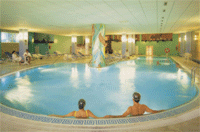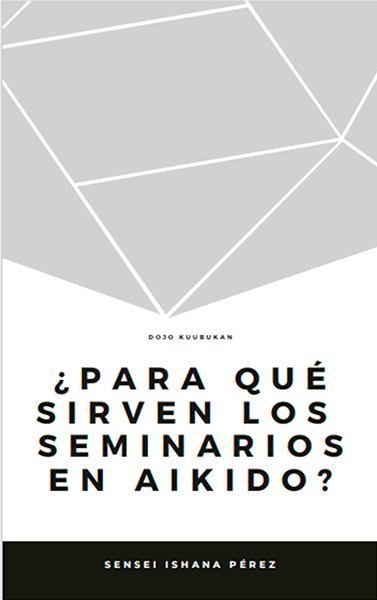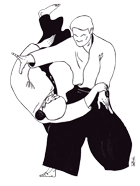

Personalized Aikido Seminar in NovemberIn Tenerife, Canary Islands.Led by: Sensei Ishana Pérez.Kyoshi Date: 8 and 9 November 2025. "Terrero de lucha del Calvario". Tenerife – Canary Islands, Spain.
The plans will have an upward progression, both in technical content, internal elements and challenges for the student. The courses will be aimed at small groups of students, with specific content to work on and limited to a specific time frame. It is a new approach within Aikido and, as far as we know, we have no evidence that it has been carried out to date. As the course will be structured by levels, those who start with the basic levels (5th and 4th Kyu) can continue to progress upwards to the higher levels (3rd and 2nd Kyu) throughout the year. Those at higher levels will undergo a process of refinement and perfection during the academic year. In this case, they must take into account that the technical approach will vary. This modification will depend on whether or not the objectives established after the first seminar are achieved. That is, if no achievements are established in the different planned contents, they would be repeated and, therefore, the initial approach would not change. It would be very helpful! If from one seminar to the next, participants had personal practice on the content taught. It is a unique opportunity, both for new instructors and for students who want to do an in-depth study of Waza individually. On the other hand, we continue to contribute to the world of Aikido forms and procedures to develop better Aikido and, as always, seeking excellence with good work.
Exchanges Kuubukan.
|
||
Day |
Time |
Activity |
Saturday 8th |
08:00 h |
|
" |
Hourly |
|
" |
Hourly |
|
" |
80:00 h to 13:00 h |
|
Sunday 9th |
Same as Saturday |
|
" |
14:00 h |
|
Material:
* Keikogui.
 Objectives for the Seminar.
Objectives for the Seminar.
The central idea and the objective to achieve in these seminars is to offer practitioners individualized teaching based on our learning curriculum. ![]()
We will address this taking into account the technical aspect of each of the different levels that arise in planning.
The skills that must be cultivated at each training level, which are related to the content to be practiced and which are always aimed at facilitating the execution of the different techniques
Nor are we going to neglect the work on the internal aspects, which correspond to the development of the dynamics and the level that is being executed.
The general concepts As it could not be otherwise, our packaging is available at the click of a button on our website To be chosen according to the interest and concerns that each practitioner has, taking into account the technical approaches we offer.
|
Technical PlanningSaturday 8th
On the other hand, it must be kept in mind that both Uke and Tori have to develop good contact through the holding of the Katatedori
T: Shihonage. T: Iriminage. T: Kaitenage, Uchi y Soto.
The first technique (Shihonage) aims to work on the central axis and extension in its execution. With the 2nd technique (Iriminage) the aim is to polish the work of Te Sabaki (see second 33 in this link) With the 3rd technique (Kaitenage) we will concentrate on the cut and the action-coordination of the legs that makes Uke lose his balance to apply the correct Nage, all this with a good unification-body coordination. Within this work of the legs, we will also contemplate the role of Uke, how to use them to have the best possible position within his circumstance of imbalance - control that Tori exercises.
|
Technical PlanningSaturday 8th
Within the dynamics of the Kyus grades or the curriculum of our Dojo, it is a basic element of the 5th Kyu, which aims to prepare the student for when he accesses the 4th Kyu, to be able to work competently on the block of techniques contained within the Morotedori attack that will be new for the student who accesses this level.
In this way, when the technical block corresponding to this hour is carried out, each technique can be addressed taking into account each of the movements carried out with this exercise, that is, carrying out the same principle in 3 different ways.
The attitude that Uke must cultivate at all times to put into practice this learning element so necessary to perform Aikido with content will be explained.
T: Ikkyo. T: Iriminage. T: Kotegaeshi. In all 3 techniques, much emphasis will be placed on keeping the elbows
|
Technical PlanningSaturday 8th
It is assumed and understood that students do not enter openly when performing these attacks, that the body does not arrive before the attack, etc., that is, it is assumed that there is already a clear basis of understanding to perform the attack correctly, in this way with this exercise we will be able to advance in these superior points within these elements. If you have any doubts about these aspects, we recommend that you read the editorial: “The courage to change.” To develop this section, a specific exercise will be done, both with Shomen and with Yokomen, either with Makiwara or working with a partner.
T: Sankyo. T: Yonkyo. T: Shihonage. What will be given priority in the first 2 techniques (Sankyo, Yonkyo), is awareness and making a lclear distinction when using the hips or the waist. This means that in the first 4 repetitions each student will use the hips and in the following 4 repetitions when it is his/her turn again, the waist will be used. In this way, the difference between the two will be experienced. Within the Nage technique, Ukemi will be advanced. Because at this level and from it onwards, there are no more basic Ukemis according to our pedagogical approaches.
|
Technical PlanningSaturday 8th In our training approach to Aikido, the demands placed on this stage of practice are comparable in other environments to the levels of consolidated Yudanshas.
So students who attend during this time must have the ability to work at that pace and with that demand in a fluid manner and with presence in action. If I don't know the size, another time and level can be chosen that is more accessible to the student's current body type.
This means being able to respond to your partner - regardless of the role you are assuming (Uke or Tori) -, adapting at all times to the circumstances created and responding with the correct Timing, that is, not arriving too late or too early with the given response.
This is done in order to be able to respond well and with flexible energy to the partner.
T: Nikkyo. T: Sankyo. T: Kotegaeshi. With the 1st technique (Nikkyo) we are going to mark the clear difference between the Omote and the Ura. This will be done by using the unified body together with a continuous movement and joined to the other with the appropriate cadence based on their responses as Uke. With the 2nd technique (Sankyo) we will approach it from an advanced level, working with great continuity in the action until concluding it with control. With the 3rd technique (Kotegaeshi) we will apply a flexible action-reaction and with the possibility that if Tori does not control Uke to turn him upside down to perform the relevant control of the Kotegaeshi, Uke can make a counter by applying Gokaku Keiko.
|
Suggestion!
It would be advisable to click on the blue links that accompany the description of the contents - objectives of the planning to have a broader and more complete understanding of the plan that we are going to carry out, because each link informs - expands the concepts to be worked on.
Technical PlanningSunday 9th
This work is essential when approaching the Shihonage technique from both the Uke and Tori perspective.
This means a correct position of the body
T: Ikkyo. T: Shihonage. T: Kaitenage, Uchi y Soto. In the 3rd technique (Kaitenage) we are going to place special emphasis, because the work from Aihnmi is usually quite overlooked by most practitioners. It should also be noted that it has a direct relationship when it has to be executed from Shomenuchi at higher levels of practice.
|
Technical PlanningSunday 9th
We will also need this resource to deal with the Tenchinage principle when tackling technical work.
This will greatly facilitate the work of the upper limbs within the Waza action, which must be cultivated when doing the entire technical block.
T: Tenchinage. T: Iriminage.
|
Technical PlanningSunday 9th
The 3 Ukes walk towards Tori with their arms extended and he will move in any direction in the space so that they cannot touch him with the arm that is extended towards him. To increase the difficulty of the exercise, the movements will be done within a previously delimited space.
Because attention must be focused on the connection established between the attack, the encounter (De-ai) and its channeling, in order to be able to apply the corresponding techniques.
T: Sumiotoshi. T: Uchi – Kaiten Sankyo.
|
Technical PlanningSunday 9th
It will be approached from two different angles, so that students are more versatile and creative when performing Waza.
The reason for applying this type of energy is because there will be 2 actions (the Shomen and the Uchi) that have to be previously united to reach the application of the different techniques.
Distinguishing between fullness and emptiness in the legs. Distinguishing between fullness and emptiness in the arms.
T: Shihonage. T: Kotegaeshi.
|
Suggestion!
It would be advisable to click on the blue links that accompany the description of the contents - objectives of the planning to have a broader and more complete understanding of the plan that we are going to carry out, because each link informs - expands the concepts to be worked on.
Do you want to improve your performance in the seminar?
If you don't know how to deal with that job, we leave you the following information related to that element to help you:
By carrying out this prior preparation on these two technical aspects, you will be able to better face any level at any time and you will be able to make better returns on your investment in your education during the seminar. For those registered for the seminar (this includes those who have reserved a place in advance) you have our
|
 * Breakfast and Snack Kuubukan quality.
* Breakfast and Snack Kuubukan quality.
Courtesy of our Dojo and between classes you can take.
 |
cafe. |
 |
Tea. |
 |
Infusions. |
 |
Fruit juice. |
 |
Fruit. |
 |
Sweet pastries. |
| After school as an appetizer: | |
 |
Beer. |
 |
Refreshments. |
 |
Appetizer of our Kuubukan Kitchen. |
 Contribution to the Aikido Seminar per Person.
Contribution to the Aikido Seminar per Person.
1 single day of seminar and doing 1 single hour per day |
€40 per person |
2 days of seminar and doing 2 hours (1 each day) |
€60 per person |
 Contribution to the Aikido Seminar for Groups.
Contribution to the Aikido Seminar for Groups.
 If 4 people come in a group they only make their contribution 3.
If 4 people come in a group they only make their contribution 3.
The amounts are as follows:
1 single day of seminar and doing 1 single hour per day |
€120 for the 4 |
2 days of seminar and doing 2 hours (1 each day) |
€180 for the 4 |
![]() Students in a group have to attend at a specific time, that is, of the 4 participants, they CANNOT enroll in different hours-levels.
Students in a group have to attend at a specific time, that is, of the 4 participants, they CANNOT enroll in different hours-levels.
 Last day to apply for the seminar: 1nd. November 2025.
Last day to apply for the seminar: 1nd. November 2025.
 To facilitate the work of the organization, you can modify the reservation or cancel it at the latest on the deadline to register (1nd. NOVEMBER 2025), after that period can not make any change or cancellation, therefore, will not be returned no amount.
To facilitate the work of the organization, you can modify the reservation or cancel it at the latest on the deadline to register (1nd. NOVEMBER 2025), after that period can not make any change or cancellation, therefore, will not be returned no amount.
 If any amount is returned, the transfer expenses are borne by the person who has canceled the place (s) to attend the Aikido Seminar.
If any amount is returned, the transfer expenses are borne by the person who has canceled the place (s) to attend the Aikido Seminar.
* Venue, contact the organization regarding payment.
 Whatsapp + 34 639 187 140
Whatsapp + 34 639 187 140
 e-mail: secretariadeldojo@yahoo.es
e-mail: secretariadeldojo@yahoo.es
 By attending our seminar is understood to authorize us to post pictures and videos on our website and social networks.
By attending our seminar is understood to authorize us to post pictures and videos on our website and social networks.
If you come accompanied the seminar and your partner does not practice, this section of our Web-Tourism Adventure- you can find plenty to do.
|
Aparthotel La Quinta Park is located in the municipality of Santa Ursula: |
 |
It is 10m. by car from the Dojo, it has easy communication since everything is a highway; It is a place with good views, pleasant climate and tranquility to recover from the effort of the seminar. Its surroundings offer many possibilities, both gastronomic and entertainment, according to the taste of each. To contact Aparthotel La Quinta Park. |
 |
 |
 |

 We present to you the 1st approach of 4 that we have planned (from 2024 to 2028) to approach Aikido seminars in a creative and instructive way.
We present to you the 1st approach of 4 that we have planned (from 2024 to 2028) to approach Aikido seminars in a creative and instructive way.
 Accommodation Recommended by the Organization.
Accommodation Recommended by the Organization. What are Aikido seminars for?
What are Aikido seminars for?
 Arrival, Etiquette, hygiene and cleaning for Aikido
Arrival, Etiquette, hygiene and cleaning for Aikido WARM-UP, free for attendees
WARM-UP, free for attendees Brief INTRODUCTION and answer some questions that the participants may have
Brief INTRODUCTION and answer some questions that the participants may have EMPTY HAND in blocks of 1 hour
EMPTY HAND in blocks of 1 hour Party at the Dojo
Party at the Dojo
 Important Note!
Important Note!